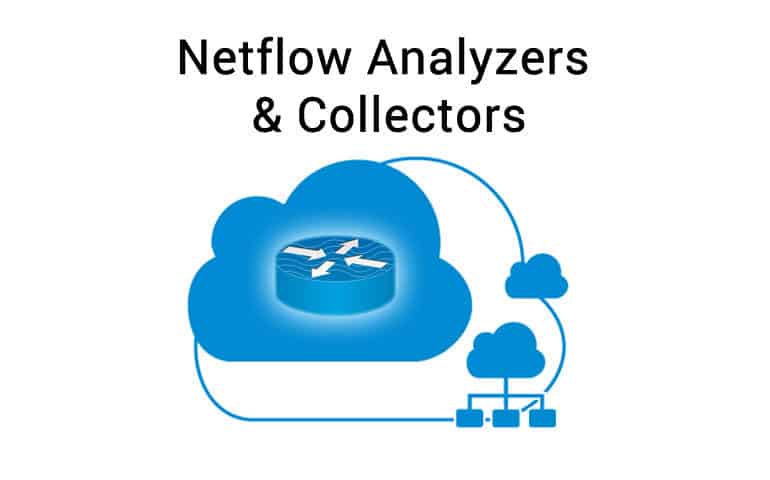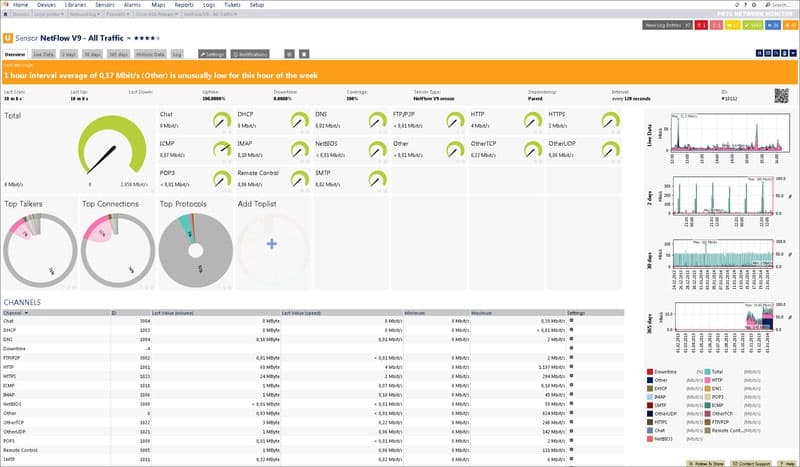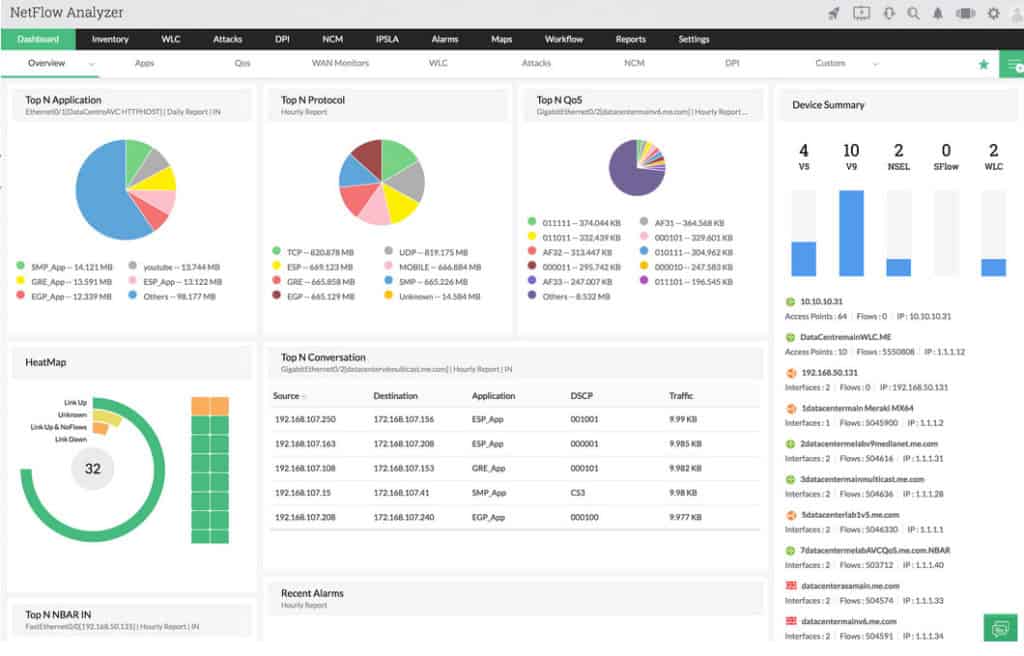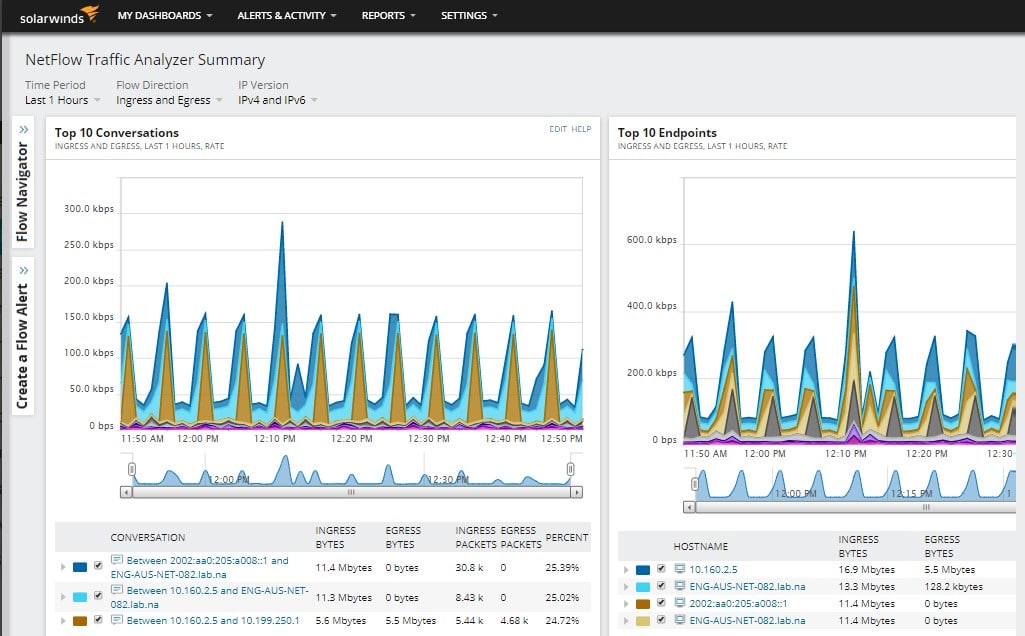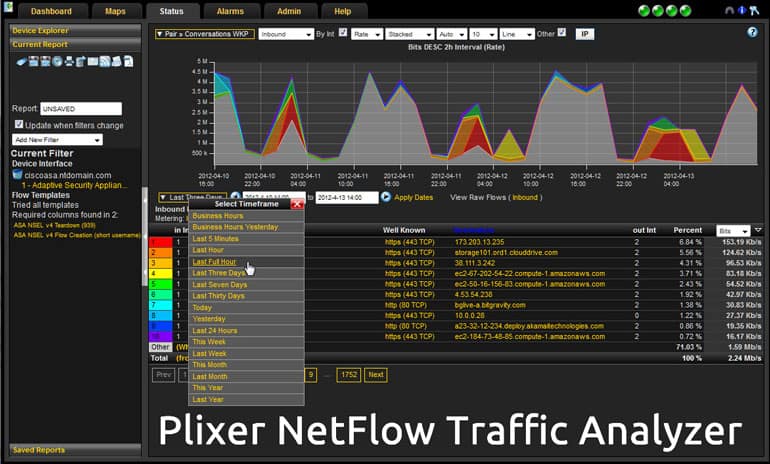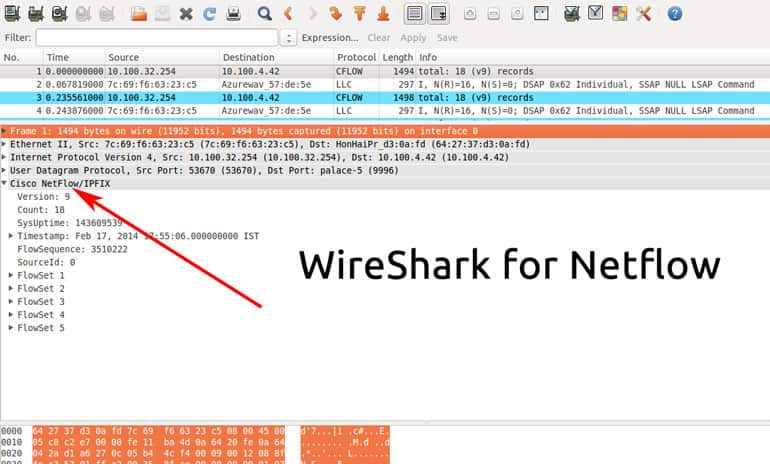NetFlow Collecting and Analysis is a great way to find out what's going on in your network and see who all the bandwidth hogs are within your organization.
Capturing Flow packets and studying them will help you find out where all your bandwidth is getting allocated and how to further stop abuse in your organization. To get a better understanding of What NetFlow is, have a look at the in-depth tutorial and definition here.
Here is our list of the Best NetFlow Analyzer and Collectors for Windows:
- Paessler PRTG – EDITOR'S CHOICE This package of monitoring tools includes a NetFlow collector with a screen in the dashboard showing live data and allowing for historical analysis as well. Available as software for Windows Server or as a SaaS platform. Get a 30-day free trial.
- ManageEngine NetFlow Analyzer – FREE TRIAL A package of traffic analyzers that includes collectors for NetFlow, sFlow, IPFIX, and other flow protocols. Available for Windows Server, Linux, and AWS. Get a 30-day free trial.
- Site24x7 – FREE TRIAL This cloud-based platform of system monitoring and management tools includes a traffic monitor that is able to collect NetFlow statistics. Get a 30-day free trial.
- SolarWinds NetFlow Traffic Analyzer A traffic scanner that partners with the Network Performance Monitor to identify bottlenecks and underutilized links.
- Plixer NetFlow Traffic Analyzer A package that provides real-time network traffic monitoring, detailed analysis, and reporting. It identifies top talkers and bandwidth usage Runs on Windows and Linux.
- Wireshark A free packet analyzer that is also able to identify and analyze NetFlow data. Available for Windows, Linux, and macOS.
- NetVizura A network monitoring package with NetFlow Analyzer for traffic analysis and bandwidth monitoring, EventLog Analyzer for log management, and MIB Browser for SNMP data management. Runs on Windows and Linux.
- Netflow Auditor This network auditing tool provides real-time analysis, long-term trending, and detailed reporting. Runs on Windows and Linux.
We've seen many instances when the internet has been crippled by someone streaming YouTube or worse, downloading Torrents illegally within the LAN environment. Catching these bandwidth hogs using one of the mentioned software packages below will help you clamp down your network and get rid of unwanted bandwidth usage.
It will also help you save money in the long run which is another added benefit. If you are looking for a more generic version, checkout our post here where we compiled a list of generic Bandwidth monitor tools and software.
Before you can analyze any sort of data, you have to capture it. By default, your networking gear may not be capturing this information, but it should be fairly easy to turn the feature on.
Here are instructions to enable tracking on Cisco and Juniper equipment. Check with your own manufacturer for similar instructions, or even a tech community like SpiceWorks.
Some of the tools we’ll discuss also have guides included to get you started.
The Best NetFlow Analysis & Collection Tools & Software
Our methodology for selecting NetFlow analyzers and Collectors
We reviewed the network monitoring tools and software market and analyzed the options based on the following criteria:
- Support for various protocols and environments
- Support for alerting and reports
- A facility to analyze network performance over time
- Graphical interpretation of data, such as charts and graphs
- A free trial period, a demo, or a money-back guarantee for no-risk assessment
- A good price that reflects value for money when compared to the functions offered
All of the tools below are free, although usually at the expense of some of the more advanced features. If you only need to find your bandwidth hogs, the free versions should be just fine. If you’re looking to lock down every single packet or find packet loss in your network, you’ll want to consider purchasing the full versions for that kind of Bandwidth monitoring and control.
Now let's talk about each option!
1. Paessler PRTG – FREE TRIAL
Paessler PRTG is a full-service monitoring solution, and their service is 100% free forever. PRTG offers users 100 free “sensors” and has been noted to be a suitable alternative to many open-source packages. A sensor can be any part of your network, whether it’s bandwidth analysis on a switch or server, an up-time monitor, CPU and Processor usage, etc.
Pros:
- Designed to be an infrastructure monitoring tool that supports multiple sensors types such as NetFlow, sFlow, and J-Flow
- Offers additional monitoring on the same platform, supporting infrastructure, network, and application performance monitoring
- Captures packet headers only, helps speed up analysis and keep storage costs down for long-term collection
- Uses simple yet intuitive graphing for traffic visualization
Cons:
- Very detailed platform takes time to learn and fully utilize all of the features available
If you outgrow its Free Features & Capabilities, you need only buy more sensors at a reasonable rate – PRTG is a Trusted Name in Network monitoring and they've come to show their capabilities in many forms, not just in the NetFlow Analyzer realm.
You can start with a 30-day free trial.
EDITOR'S CHOICE
Paessler PRTG is our top pick for a NetFlow analyzer and collector because it offers a comprehensive, user-friendly solution for live network traffic and performance monitoring. Its advanced NetFlow analysis capabilities allow businesses to track bandwidth usage, identify traffic patterns, and pinpoint any potential bottlenecks or security issues. By collecting flow data from devices such as routers, switches, and firewalls, PRTG provides detailed insights into how network resources are being utilized, helping administrators optimize performance and manage network capacity effectively. PRTG is a flexible package with a customizable dashboard. The tool allows users to visualize NetFlow data in intuitive graphs and charts. These visualizations make it easy to monitor network health and performance metrics, such as latency, throughput, and traffic types, in real time. PRTG offers automated alerts that notify administrators of any abnormalities or deviations from normal traffic patterns, allowing for proactive network management and issue resolution. The tool also supports multiple flow protocols, including NetFlow, sFlow, and IPFIX, making it compatible with a wide range of network devices. Paessler PRTG’s scalability ensures it can accommodate networks of any size, from small businesses to large enterprises.
Download: Get a 30-day FREE Trial
Official Site: https://www.paessler.com/download/prtg-download?download=1
OS: Windows Server and SaaS
Related post: See our analysis between PRTG vs Nagios for Network Monitoring
2. ManageEngine NetFlow Analyzer – FREE TRIAL
ManageEngine NetFlow Analyzer makes it easy to view and understand your traffic at a glance. The clean interface and helpful graphs give you all the information you need right away, and the automatic recognition of suspicious activity is very helpful.
Pros:
- Supports multiple protocols like NetFlow, great for monitoring Cisco equipment
- Both tools work well alongside each other to help view traffic patterns and bandwidth usage
- Easy-to-use interface automatically highlights bandwidth hogs and other network traffic outliers
- Scale well, designed for large enterprise networks
- Can view traffic on a per-hop basis, allowing for granular traffic analysis
Cons:
- Built for enterprise use, not designed for small home networks
The free edition will only monitor two interfaces at once. You can start with a 30-day free trial.
3. Site24x7 – FREE TRIAL
Site24x7 is a powerful NetFlow analyzer that provides deep insights into network traffic by capturing and analyzing flow data from NetFlow-enabled devices. With its support for multiple flow protocols, including NetFlow, sFlow, and IPFIX, Site24x7 offers comprehensive visibility into bandwidth usage, application performance, and user behavior across networks.
The platform’s customizable dashboards and detailed reports help administrators track traffic patterns in real-time, identify potential bottlenecks, and ensure efficient resource allocation.
Site24x7’s advanced features, such as historical data analysis and customizable alerts, allow businesses to proactively monitor and troubleshoot network issues, ensuring optimal network performance and security.
The entire Site24x7 platform is based in the cloud. It provides monitoring and management tools for all IT assets, including networks, endpoints, applications, cloud services, and Web assets. The package is sold in editions that give access to all of the modules on the platform.
Pros:
- Provides immediate insights into network traffic and performance
- Sends alerts based on predefined thresholds to quickly address issues
- Generates in-depth reports for performance analysis and capacity planning
Cons:
- No on-premise version
Prices start at $9 per month for the Infrastructure Monitoring package. Get a 30-day free trial.
4. SolarWinds NetFlow Traffic Analyzer
SolarWinds makes great tools for managing your entire network, from servers to VMs to network traffic. The full Suite allows you to keep tabs on all your devices wherever they may be and send alerts when something goes awry.
The SolarWinds NetFlow Traffic Analyzer is only a part of that larger suite, but it will analyze the network traffic in real time and show you any issues it finds. The NTA Suite from SolarWinds has full functionality to analyze other flow protocols, including sFlow, J-FLow, ipfix, and Netstream as well.
It offers a wide variety of customization and other standard features out of the box that many other software platforms don't come with.
Pros:
- Supports multiple protocols like NetFlow, great for monitoring Cisco equipment
- Both tools work well alongside each other to help view traffic patterns and bandwidth usage
- Easy-to-use interface automatically highlights bandwidth hogs and other network traffic outliers
- Scales well, designed for large enterprise networks
- Can view traffic on a per-hop basis, allowing for granular traffic analysis
Cons:
- Built for enterprise use, not designed for small home networks
We recommend you Download it and try it for FREE to familiarize yourself better with its capabilities! To determine your network requirements, start with this 30-day free trial.
5. Plixer NetFlow Traffic Analyzer
Plixer Scrutinizer will show you a comprehensive snapshot of your network as it currently exists, but the free version only shows the last five hours’ worth of data, making long-term analysis impossible without purchasing the full version. Still, the amount of data available is pretty impressive and it’s presented in such a way that it’s not difficult to pick apart and understand what’s happening.
For a Quick and Dirty analysis of Flow data, this might be a good tool for you to utilize – but if you're looking for a longer-term solution, you will need to purchase a license!
Pros:
- Offers multiple deployment options
- Designed to support large enterprise networks
- Offers additional security-related traffic analysis features
Cons:
- Must reach out to sales for pricing
- Steeper learning curve than similar tools on the market
6. Wireshark
Perhaps you’re simply not interested in all of those fancy bar graphs and pie charts. Maybe you just want to dig right into the raw data and pick it apart that way.
If that’s what you need to accomplish, there’s no better tool than Wireshark. The learning curve is extremely steep, but once you know what you’re doing, Wireshark will give you as much information as you can handle, and then some.
The hardest part about Wireshark is actually filtering out all the extraneous data that you don’t need in order to make sense of what’s left. Lucky for many of us, SolarWinds has a Response Time Viewer for Wireshark that makes sorting and searching for events much easier, you can see the full review here.
Pros:
- One of the most popular sniffer tools, with a massive community behind it
- Open source project that adds new features and plugins
- Supports packet collection and analysis in the same program
Cons:
- Has a steep learning curve, designed for network professionals
- Filtering can take time to learn and collects everything by default which can be overwhelming on large networks
If you don't mind excessive amounts of data at your fingers, then there’s nothing quite like Wireshark!
7. NetVizura
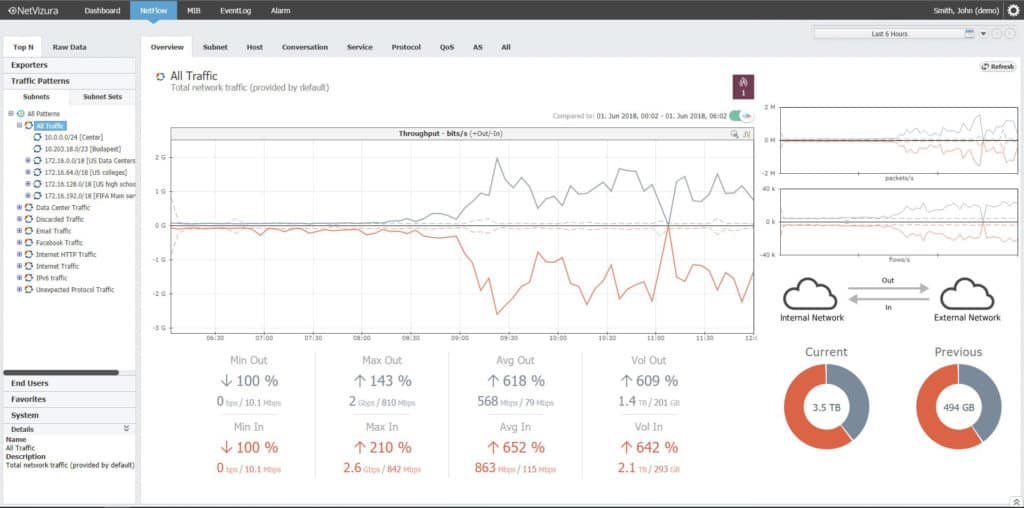
NetVizura NetFlow Analyzer is a solution for a better understanding of bandwidth consumption, traffic trends, applications, hosts, and traffic patterns, by visualizing the traffic by networking devices, interface ports and sub networks, traffic segments, and clients.
NetVizura uses primarily NetFlow but has functionality for IPfix, NSEL, sFlow, and compatible flow protocols to help with the analysis of Bandwith usage, packet sniffing, and reporting features.
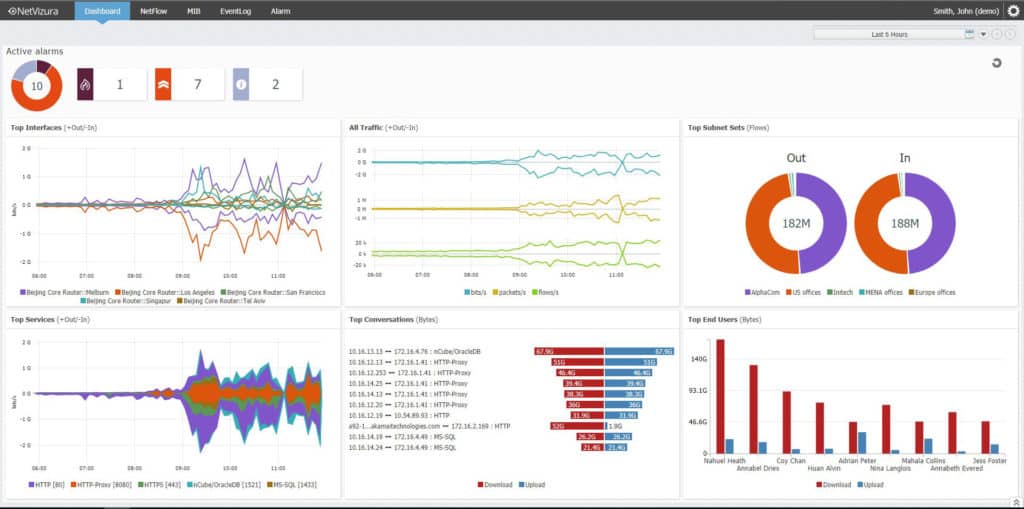
Enabling networks and applications optimization, planning network expansion, saving time needed for troubleshooting and diagnostics, and improving security leads to considerably lowering company operational costs and increasing network team productivity.
The main use cases for NetVizura NetFlow Analyzer are:
- Bandwidth Consumption Analysis – if there are interfaces that are overloaded and over-congested, you can dive into reasons why this happened
- Specific (Custom) Traffic Monitoring – if there are some vital segments of your traffic (such as servers, services, sites, or clients) that you would like to monitor and that are not visible to standard NMS solutions
- End User Monitoring – quickly discover who is behind IP, see how employees are using your network for better optimization and planning if there is any misuse or abuse of network resources
- Security Incidents Alarming & Diagnostics – If there are some anomalies in your traffic you can detect them fast and easily (such as DDoS, Data leak, Port scan, Blackoling review, and Employee abuse), and find out the causes for these anomalies
Pros:
- Can process high volumes of logs, making it a solid option for larger companies
- Robust search filters help sort by severity, application, or timeframe
Cons:
- No month-to-month pricing options
8. Netflow Auditor
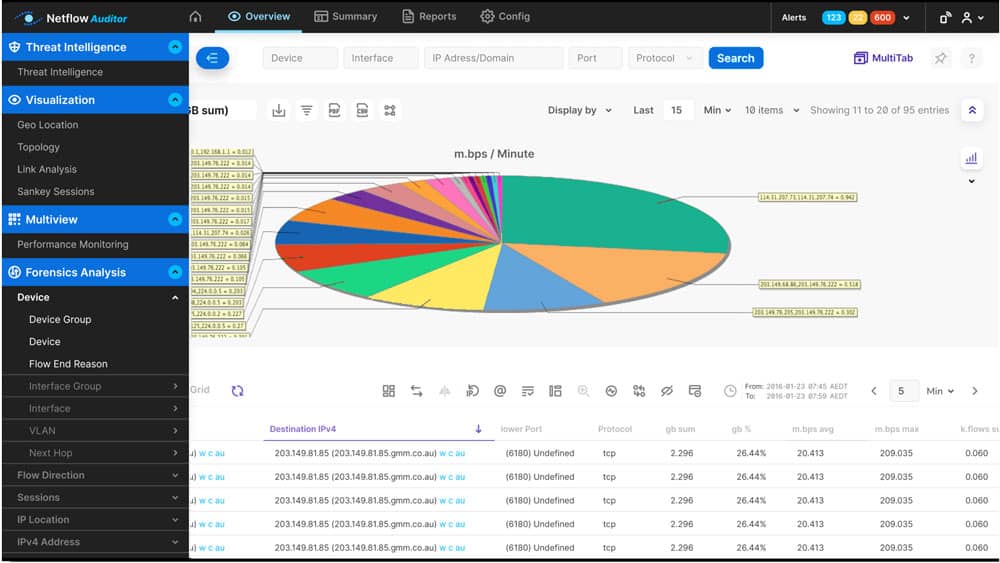
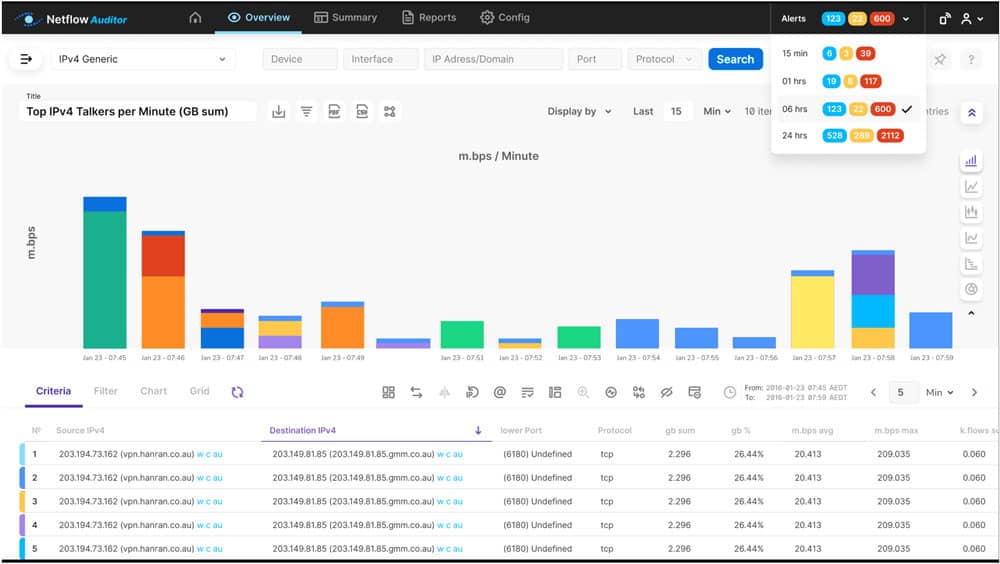
Netflow Auditor by IdeaData is a great tool for visualizing Flow data in real-time and understanding the type of traffic and bandwidth usage in your network. This tool has a 30-day free Trial to get a feel of how it works and installed in your network.
Some Notable features of this tool include:
- Monitoring without the need for probes using Netflow versions 1, 5, 7, and 9, as well as IPFIX.
- View Bandwidth utilization statistics, including Current, Avg, and Peak Utilization periods and times.
- View Historical Usage reports by IP Address, Protocol, Application, QoS, and many other customizable fields and parameters.
- Filter Data into Easy-to-Read and Digest Reports for End users.
- and many more features
You can see all their Features and Capabilities on their Details page here!
Pros:
- Offers a suite of networking and NetFlow services
- Supports IPFIX, sFlow, J-Flow, and more
- Cross-platform – available for both Windows and Linux
- Great interface and reporting capabilities
Cons:
- Can take time to fully explore all aspects of the platform
Final Words
We hope this article has at least given you a starting point for where to find a good NetFlow collector and Analyzer for dissecting Flow data from your Network device.
Many, if not all of these software and tools above, have a Free version to use for either a limited amount of days/time or Sensors.
We suggest you download a couple of the NetFlow analyzers and Collectors from above to get a feel of the options and capabilities they can offer you before making concrete decisions!
Happy monitoring!
Netflow Analyzer and Collectors for Windows FAQs
What is a Netflow analyzer?
A Netflow analyzer is a tool that can analyze and report on network traffic flows, providing insights into traffic patterns and usage.
What is a Netflow collector?
A Netflow collector is a tool that can collect and store Netflow data for later analysis.
What are some common Netflow analyzer and collector tools?
Common Netflow analyzer and collector tools include SolarWinds NetFlow Traffic Analyzer, Plixer Scrutinizer, and Cisco NetFlow Collector.
What are some common challenges associated with using Netflow analyzers and collectors?
Common challenges associated with using Netflow analyzers and collectors can include managing large volumes of data, ensuring compatibility with existing infrastructure, and interpreting data to make meaningful decisions.

